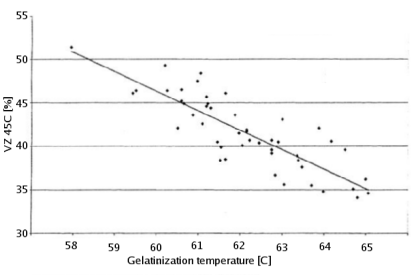Starch Conversion
From German brewing and more
[Shetty, 2006]:
- gelatinization: heating in excess water, endothermic reaction, loss of crystalline order
- irreversible w/r to the shape of the granule
- amylopecting and amylose may form new structures when cooled down -> retrogradation
- during heating -> swelling to up to 30x its weight. reversible process
- retrogradation is cause for hard stale bread
[Donald, 2004]
- irreversible order -> disorder transition called gelatinization.
- swell, absorb water, leach amylose, loose crystallinity.
- birefringence is lost
- range is quite large for all granules 56-64 for wheat and potato but much smaller (1 C) for individual granules
- substantial swelling
- inital water absorption in the amorphous growth rings
- swelling driven process
- crystalline regions break open b/c of the swelling
- if water is limited (high density or presence of sugars) swelling doesn't take place as well and a melting of the crystalline sections needs to happen
- gelatinization temperature increases
- Maize starch: from 70C to 78C when placed in 25% sugar solution.
- sugar removes free water
[Briggs, 2004]
- sugar concentration raises gelatinization temperature
- enzymatic breakdown should happen before retrogradation occurs
- some starches require cooking temps between 90 and 120C (194-248F) before amylose lipid complexes are broken -> one of the reasons why cooking of some adjuncts is necessary.
- gelatinization temperatures of various starches (page 38), create table
[Narziss, 2005]
- starch is insoluble in cold water
- granules start to swell (50C +)
- then they get small fissures
- amylose leaches out
- amylopectin separates as gelatenous sheet
- viscous and sticky mass is formed\
- doesn't happen in mashing b/c of the enzymes
- but may cause problems in cereal cookers (especially rice)
[Kunze, 2007]
- 4 phases: ungelatenized, gelatinization, liquification, saccharification
- gelatinization temp dependent on growing conditions and crop year : 59 - 65C
[Kessler, 2008]
- VZ45 shows some correlation to gelatinization temperature
- gelatinization
- active enzymes
- emzyme temperature and pH optima
- mash parameters affecting conversion
References
- [Valclavik] Vickie A. Valclavik, Elizabeth W. Christian, Essentials of Food Science, Third Edition, Springer
- [Champe] Pamela C, Champe, Richard A. Harvey, Denise R. Ferrier, Biochemistry, Lippincott's Illustrated Reviews
- [Kunze, 2007] Wolfgang Kunze, Technologie Brauer und Maelzer, 9. Auflage, VLB Berlin
- [Narziss, 2005] Prof. Dr. agr. Ludwig Narziss, Prof. Dr.-Ing. habil. Werner Back, Abriss der Bierbrauerei, Technische Universitaet Muenchen (Fakultaet fuer Brauwesen, Weihenstephan). WILEY-VCH Verlags GmbH Weinheim Germany, 2005
- [Donald, 2004] A. M. Donald, Understanding Starch Stucture and Functionality, Chapter 5 in Starch in Food: Structure, Function and Applications By Ann-Charlotte Eliasson, CRC Press, 2004
- [Shetty, 2006] Kalidas Shetty, Food Biotechnology, CRC Press, 2006
- [Kessler, 2008] Dr.-Ing. Matthias Kessler, Dr.-Ing. Stefan Kreisz. Dipl.-Ing. Martin Zarnkov. Univ.-Prof. Dr.-Ing. Werner Back, Do Brewers need a starch modification index?, Brauwelt International, 2008/1



